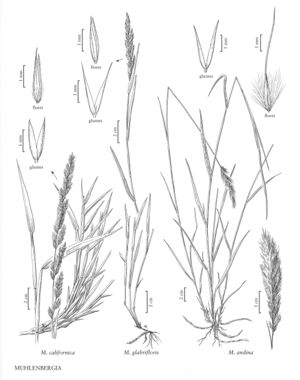Difference between revisions of "Muhlenbergia californica"
FNA>Volume Importer |
FNA>Volume Importer |
||
| Line 17: | Line 17: | ||
-->{{Treatment/Body | -->{{Treatment/Body | ||
|distribution=Calif. | |distribution=Calif. | ||
| − | |discussion=<p>Muhlenbergia californica grows in canyons, along moist ditches, and on sandy slopes, at elevations of 100-2150 m. It is endemic to the Transverse Ranges of southern California.</p> | + | |discussion=<p><i>Muhlenbergia californica</i> grows in canyons, along moist ditches, and on sandy slopes, at elevations of 100-2150 m. It is endemic to the Transverse Ranges of southern California.</p> |
|tables= | |tables= | ||
|references= | |references= | ||
| Line 26: | Line 26: | ||
-->{{#Taxon: | -->{{#Taxon: | ||
name=Muhlenbergia californica | name=Muhlenbergia californica | ||
| − | |||
|authority=Vasey | |authority=Vasey | ||
|rank=species | |rank=species | ||
| Line 33: | Line 32: | ||
|basionyms= | |basionyms= | ||
|family=Poaceae | |family=Poaceae | ||
| − | |illustrator=Linda A. Vorobik | + | |illustrator=Linda A. Vorobik;Annaliese Miller |
| + | |illustration copyright=Utah State University | ||
|distribution=Calif. | |distribution=Calif. | ||
|reference=None | |reference=None | ||
| Line 39: | Line 39: | ||
|publication year= | |publication year= | ||
|special status= | |special status= | ||
| − | |source xml=https:// | + | |source xml=https://jpend@bitbucket.org/aafc-mbb/fna-data-curation.git/src/f50eec43f223ca0e34566be0b046453a0960e173/coarse_grained_fna_xml/V25/V25_714.xml |
|subfamily=Poaceae subfam. Chloridoideae | |subfamily=Poaceae subfam. Chloridoideae | ||
|tribe=Poaceae tribe Cynodonteae | |tribe=Poaceae tribe Cynodonteae | ||
Revision as of 21:37, 16 December 2019
Plants perennial; rhizomatous, not cespitose. Culms 30-70 cm tall, 0.7-1.5 mm thick, decumbent; internodes dull, smooth, and glabrous for most of their length, sometimes strigose immediately below the nodes. Sheaths shorter than the internodes, scabrous, margins whitish; ligules 0.8-2 mm, membranous, truncate, ciliolate, irregularly toothed; blades 4-16 cm long, 2-6 mm wide, flat, scabridulous abaxially, scabrous to strigose adaxially. Panicles terminal, 5-13 cm long, 0.5-2.2 cm wide, dense; branches 0.5-3.2 cm, ascending, appressed or diverging up to 20° from the rachises; pedicels to 1.5 mm, stout, strigose; axillary panicles not present. Spikelets 2.8-4 mm. Glumes subequal, 2.5-4 mm, nearly as long as or slightly longer than the lemmas, scabrous (especially on the veins), 1-veined, tapering from the base to the acuminate apices, usually unawned, awns, if present, to 1.2 mm; lemmas 2.8-4 mm, narrowly lanceolate, with soft hairs on the calluses and lower portion of the lemma bodies, hairs to 1 mm, apices scabridulous, acuminate, awned, awns 0.2-2.2 mm; paleas 2.8-4 mm, subequal to the lemmas, narrowly lanceolate, with short (less than 1.5 mm), soft hairs on the lower 1/2, apices scabridulous, acuminate; anthers 1-1.7 mm, yellow. Caryopses 1.7-2 mm, fusiform, brown. 2n = 80.
Discussion
Muhlenbergia californica grows in canyons, along moist ditches, and on sandy slopes, at elevations of 100-2150 m. It is endemic to the Transverse Ranges of southern California.
Selected References
None.
